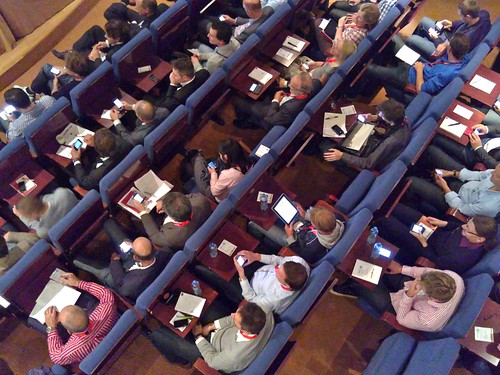A very common complaint about webinars and other synchronous online meetings is poor audio and video quality. This is generally caused by a number of factors, for example not checking your computer's audio and video settings and putting too much trust in wireless connections (wifi). I am involved an a lot of webinars, as organiser, host, speaker and participant, and this is a recurrent issue that causes lots of badwill towards online meetings. The wifi issue is particularly tricky since wifi access is now so popular and it's hard to convince people that it presents serious issues for synchronous high bandwidth communication.
There's an excellent post on this topic on Ken Molay's webinar blog, WiFi Wreaks Webinar Woes. He explains why wifi is not ideal for webinars, especially for those who need to be seen and heard in the session. Wifi is fine for participants but far too inconsistent for hosting.
The problem with WiFi for streaming content is that it is inconsistent. Even running the standard pre-webinar quality tests is no guarantee of performance thirty minutes (or thirty seconds) later. A little bit of interference from other signals on the same channel, a small shift in your device's antenna orientation, or instantaneous local load as your neighbor starts to stream a movie or download a giant email attachment can interrupt the flow of data to your system.
I've had quite a few webinar flops at conference venues who assured me that they had an excellent wifi connection and there was no need for wired internet connections. However once you assemble a couple of hundred eager e-learning experts, each with at least two devices, in a conference venue the available bandwidth for a single user often gets strangled. A webinar tool like Adobe Connect that streams video, audio, presentation slides, chat, participant lists, polls and more, chews up an awful lot of bandwidth and is very sensitive to delays. The success of the webinar depends on everyone seeing and hearing the same thing at the same time and being able to answer polls and chat questions. If some are experiencing delays everything gets out of sync. The result is a session with long delays making interaction impossible and often wild variations in sound and video quality. Sometimes it simply gives up and crashes. I always insist on a wired connection when hosting webinars from conference venues but even then there can be trouble just around the corner. At one venue I had a wired connection that worked very poorly and after enquiries I found out that the wire simply went to a wireless router and a wifi connection! At another conference the audience was asked to stop using their devices for a while because the keynote speaker couldn't show a film due to lack of bandwidth. In such cases there should be a separate internet connection for speakers so they don't get mixed up with the conference buzz.
I am not an expert on the technical side so I'm sure there are factors in this that I haven't realised but I think one of the problems here is that we have become so accustomed to everything working all the time that we take bandwidth for granted. As soon as we get more bandwidth we use even more of it and quickly reach congestion level again. E-meeting tools are constantly trying to find new ways of compressing sound and video but unless they can use a dedicated link with guaranteed bandwidth the troubles will probably continue. Ken Molay's article offers no real solution to this problem at present. However it would be good to increase awareness of the limitations of bandwidth and why the problems that are often linked to webinars are often not the fault of the tools or the organisers.
I am not an expert on the technical side so I'm sure there are factors in this that I haven't realised but I think one of the problems here is that we have become so accustomed to everything working all the time that we take bandwidth for granted. As soon as we get more bandwidth we use even more of it and quickly reach congestion level again. E-meeting tools are constantly trying to find new ways of compressing sound and video but unless they can use a dedicated link with guaranteed bandwidth the troubles will probably continue. Ken Molay's article offers no real solution to this problem at present. However it would be good to increase awareness of the limitations of bandwidth and why the problems that are often linked to webinars are often not the fault of the tools or the organisers.

No comments:
Post a Comment
Note: Only a member of this blog may post a comment.